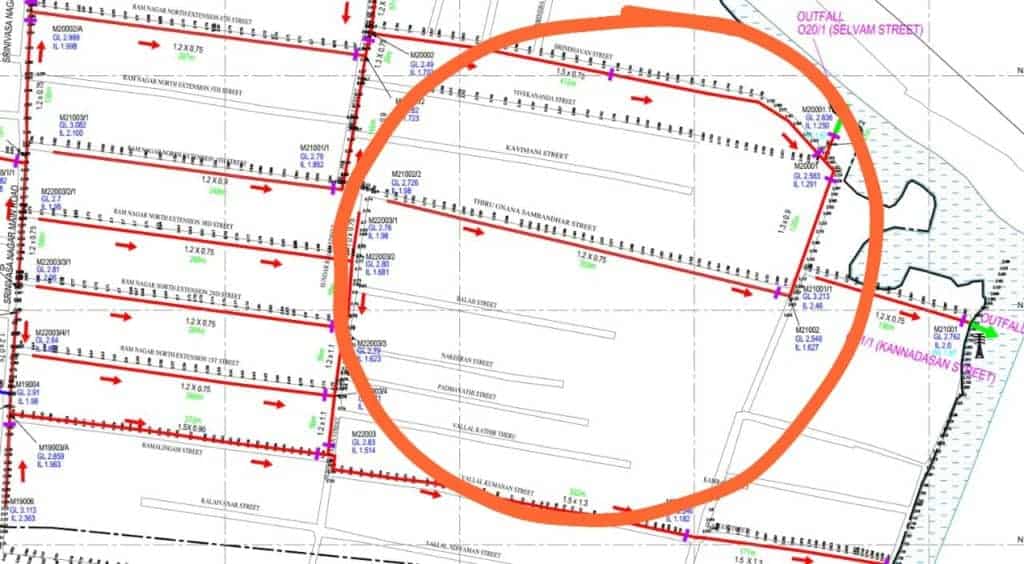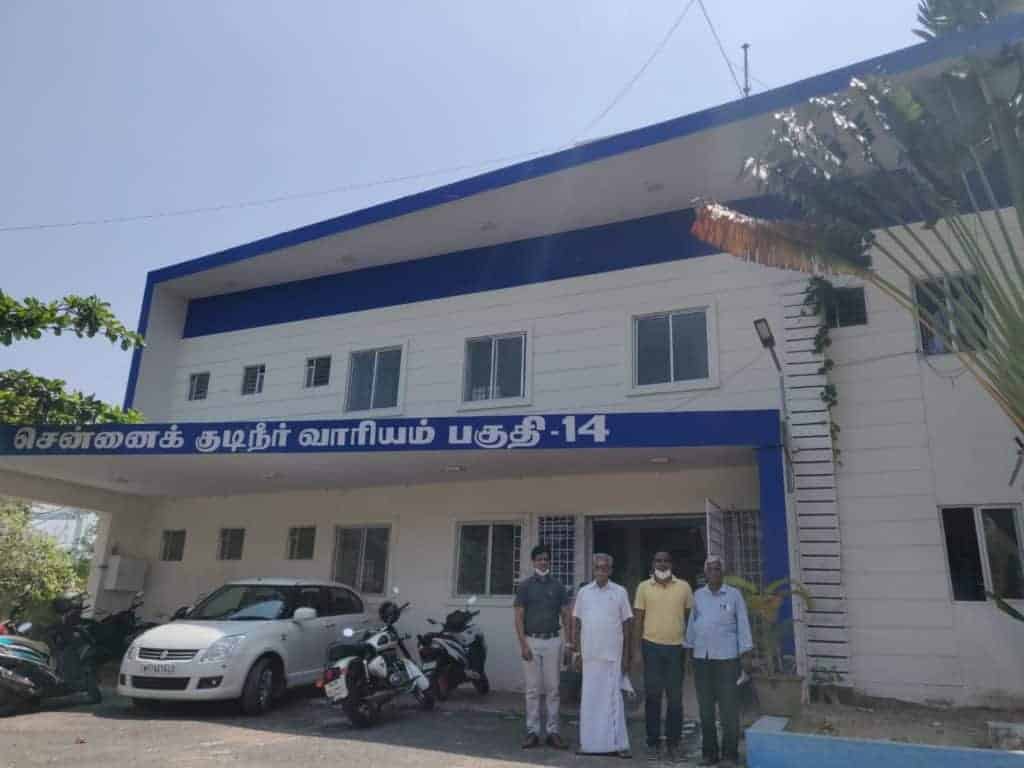Many areas that were merged with the Greater Chennai Corporation (GCC) in 2011 are yet to receive many civic amenities and services. The residents of Ullagaram-Puzhuthivakkam’s Srinivasa Nagar and Ram Nagar have been experiencing issues with water supply and sewage. Many in the area do not have what should be basic civic amenities and have been raising the issue with great fervour over the past few months.
There are a few reasons for the problems faced by residents with water supply and sewage connections, as we have understood from our talks with city officials and engineers. These include improper and delayed laying of water and sewage pipes, exclusion of households due to changes in ward boundaries, technical difficulties and dependence on desalination plants for water supply.

Read more: Citizens unhappy over hint of likely hike in water charges
Delimitation hampering schemes
In 2009, a water pipeline project was announced for Puzhuthivakkam and adjoining areas that would bring water connections to all the households. While pipelines were laid for a few houses when the scheme was announced, the connections were finished only in 2019 prior to the general elections.
The scheme was launched when the area was a Grade-III municipality. But then, the Ullagaram-Puzhuthivakkam area was merged with the Greater Chennai Corporation (GCC) as part of Zone 14 (Perungudi). The merger of the former municipality with the GCC took place in October, 2011. Over the next few years, ward boundaries were also shifted around in 2016 and 2018.
The result of such delimitation exercises was that scattered connections were set up within the same streets, due to a lack of consideration for geographic continuity in the mapping and planning process. This meant that along the same streets, some houses were included as part of different wards over time.
In Srinivasa Nagar, out of the 13 streets, only three fourths of each street have water and sewage connections. Houses on the eastern edge of the neighbourhood have been marked as ‘outside the ward boundaries’ or even as ‘incomplete streets’ outside of the concerned metro water depot’s limits. As per these boundaries some households come under Madipakkam and the rest under Puzhuthivakkam. As a result, they have been excluded from schemes for Puzhuthivakkam. So even though these residents stay in the same street, and are paying the same taxes, they don’t have basic water and sewer connections.
The delimitation of wards has also reflected in the planning and implementation of storm-water drains in these flood prone areas. In the Kovalam Integrated Storm Water Drain Project, drawings from the tender documents show how many streets within Srinivasa Nagar have been excluded from the project. Many of the excluded streets were marked as incomplete, even though people live there.
According to Greater Chennai Corporation Officials, this could be due to the fact that zonal officials have been using an outdated map of Perungudi to plan the project. Streets such as Vivekananda Street, Kavimani Street, Balaji Street, Nakeeran Street, Padmavathi Street and Vallal Kathir Street were shown as incomplete streets in the project map.

Intermittent and contaminated water supply
The residents of the area who do have water connections have been receiving discoloured water for quite a few years now. The issue was relatively manageable, as many of us allowed the water from the main pipeline to flow out for 30 to 40 minutes until the colour and odour of the water were both of acceptable standards. Water supply was scarce however, as the water would only come at around 5:30 in the evening for an hour and a half, for only two days a week.
Things took a turn for the worse in January 2022 when some residents reported the water from the main pipeline to be dark grey in colour, smelling like sewage and having a tendency to lather. What was clear was that the drinking water was getting mixed up with sewage indicating leakages in sewage pipelines and mixing of sewage outflow and water inflow.
Members of the Srinivasa Nagar Residents Welfare Association raised complaints at the portal of the Chennai Metropolitan Water Supply and Sewerage Board (CMWSSB) about the water contamination issue. In response to this, the civic body began digging the streets based on inputs from the residents and found that there has been sewage overflowing from one of the nearby streets.
There are several reasons behind such issues with the water as residents face. For one, the provisions that were made for water supply to pipelines of individual houses had remained unused for several years, potentially becoming sources of contamination of water flowing through the pipeline network. Over time these pipelines were also damaged due to bulldozing in certain parts of the area as part of road laying projects in 2016 by the GCC.
A lack of coordination between the GCC and the CMWSSB has also worsened the situation. There have also been several delays in laying of the pipelines due to local political interference in the contract procedures. The price of materials had meanwhile escalated during this period of delay. As a result, low quality pipelines were laid in the process.
Water shortage is exacerbated due to dominance of water tanker lorries. The Over Head Tank (OHT) in Annai Theresa Nagar of Puzhuthivakkam was primarily meant to serve the drinking water pipeline network of the area. However, it is being prioritised to fill up the water tanker lorries. Only the remaining amount is supplied for a limited period twice a week. Residents are not aware where the water collected by tankers from here is supplied. Some residents are of the opinion that the water tanker lorry association lobby is a reason as to why the the CMWSSB has not increased the quantum and frequency of supply.
Read more: Within GCC limits since 2011, Thoraipakkam still waiting for piped water and sewage system
Slow progress on addressing issues
After an online complaint was filed by the residents, the Area Engineer of the ward oversaw the digging up of pipelines to identify the problem. Leakages in the sewage pipelines were identified. After a month however, the complaint was closed, with the promise that the matter would be dealt with within a month. However, a month later the contamination still persisted.
The welfare associations of the area viz. Srinivasa Nagar Residents Welfare Association and Social Service Trust (Ram Nagar) then took our grievances to the CMWSSB’s monthly open house meeting. While the officials at the open house meeting said they would look into it, the progress has been slow.
Following this, a petition was drafted by the RWAs to meet with the area officials at Perungudi Zone 14 office. During this meeting, a number of demands were raised. The first was an increase in the quantum and frequency of water supply as residents were only receiving water twice a week. Along with the first demand, the petitioners requested for the water to be supplied during the morning hours, as grievance redressal would be easier.

The second demand was an increase in the quantum of water coming in during the specific slot. Due to the water being contaminated, many residents have to leave their water running for 30 to 40 minutes before cleaner water starts coming in. As a result, the quantity of water received is never enough. In response to this the Zonal officials agreed to supply water for two hours on Tuesdays and Fridays.
After this meeting, residents began receiving water supply in the morning hours for two hours on Tuesdays and Fridays. However, the issue of contamination still persists to date, and sewer connections are yet to be set up in many households.
Consultative process necessary
A key demand that was stressed upon during the meeting was the formation of a committee of engineers in collaboration with the associations in the area, to audit the functioning of the entire pipeline network.
In addition to the above demands, the residents in the area also request that a committee be formed to regularly check how the system is running. The findings or status should then be communicated to residents. In addition, it is important to make sure that everything related to residents’ basic facilities is communicated to the officials at the higher level, so that the powers that be are aware of the issues at the ward level.
Only in this way can the systemic issues be redressed in a coordinated manner, involving the residents, ward level officials and the highest authorities of decision making. Such a consultative process would be the best recourse in resolving these long-pending issues in the area.
Errata: The byline for this article had been mistakenly accorded to T V Hariharan in the first published version and has been changed following a clarification from the citizen team working on the mentioned issues.
ALWAYS WATER PAUCITY , BUT IF PAID, WATER IS AVAILABLE THROUH LORRY HOW??